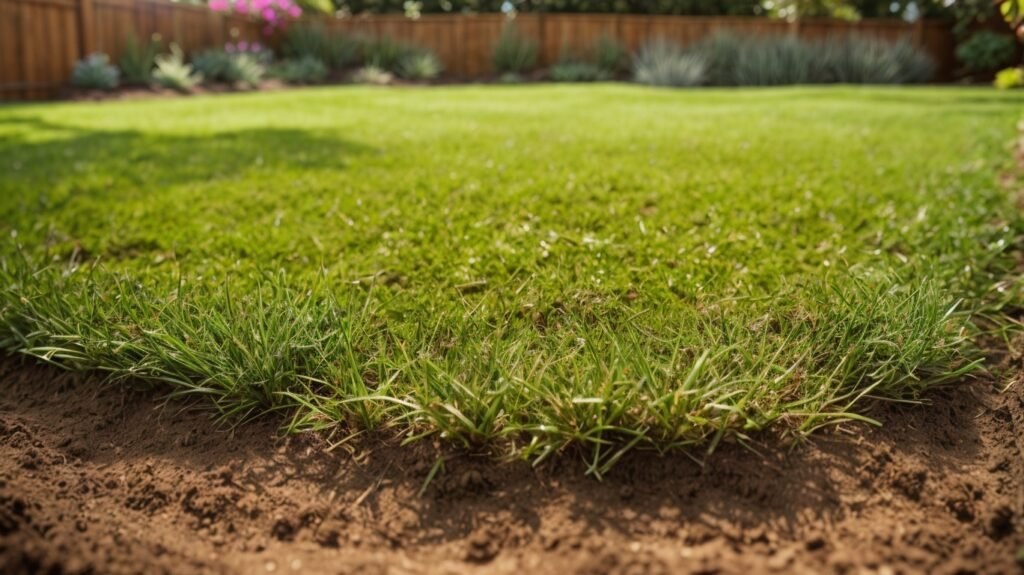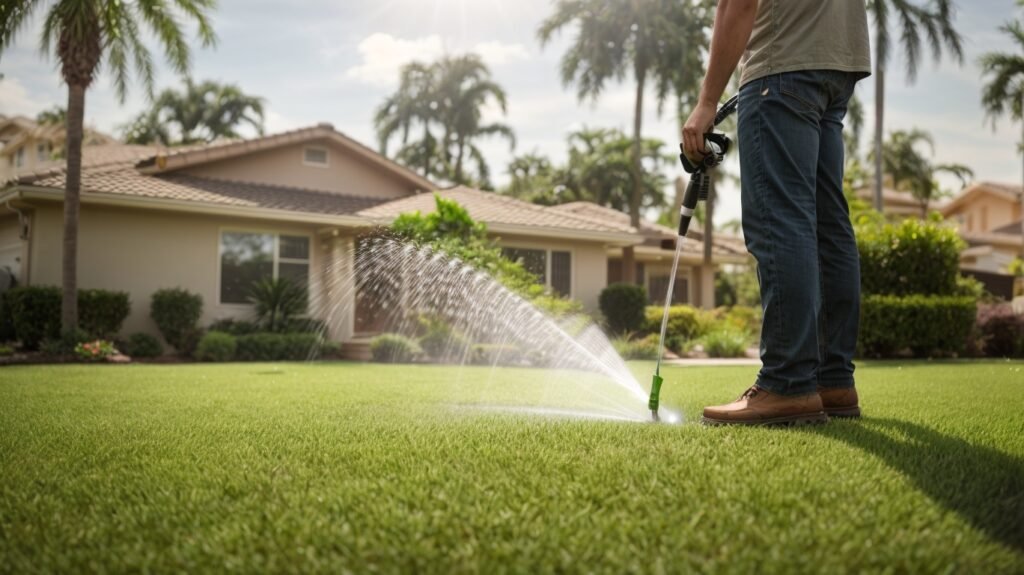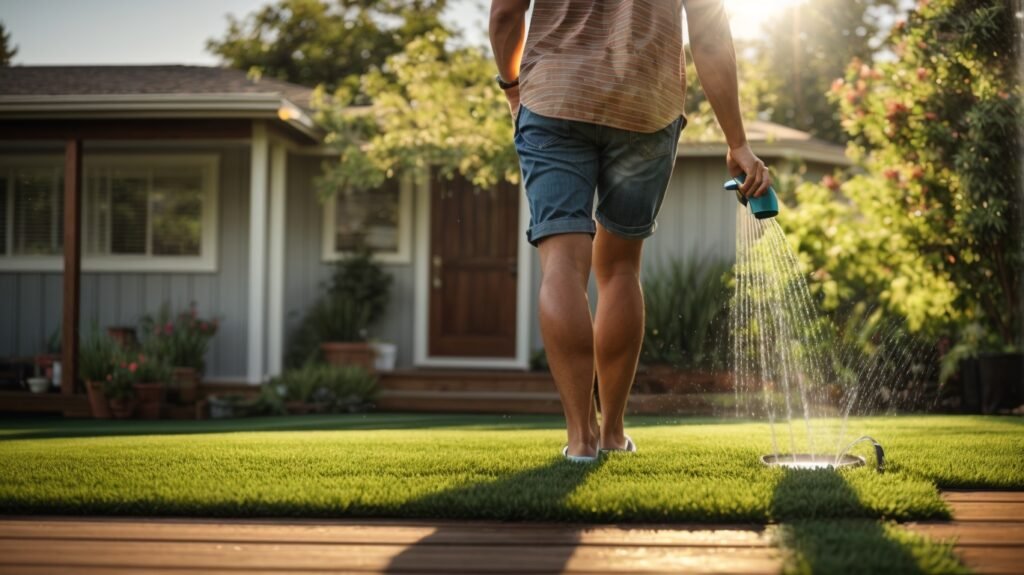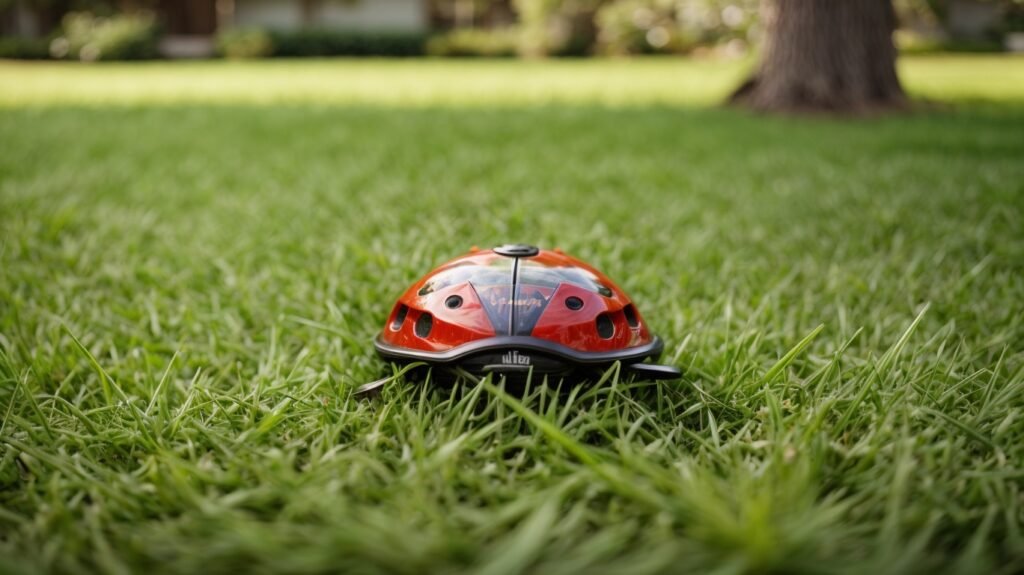Taking proper care of your St. Augustine grass is crucial for achieving a healthy and lush lawn. This warm-season grass is durable and salt-tolerant, making it an excellent choice for coastal areas. However, it requires regular maintenance, including irrigation, fertilization, and pest control, to keep it looking its best.
Key Takeaways
- St. Augustine grass is a warm-season grass commonly used in warm climates.
- It forms dense mats and is ideal for coastal areas due to its salt tolerance.
- Regular irrigation and fertilization are necessary to maintain a lush lawn.
- St. Augustine grass should be planted in spring or summer and given well-drained soil and full sun.
- Regular mowing, dethatching, aeration, and pest control are essential for healthy St. Augustine grass.
Understanding Soil Requirements
To ensure the best conditions for your St. Augustine grass, it’s important to understand its specific soil requirements. St. Augustine grass thrives in well-drained soils with a slightly acidic pH level between 5.0 and 6.5. It prefers soil that is rich in organic matter and has good fertility. The composition of the soil, including its texture and structure, also plays a crucial role in the growth and health of your lawn.
When it comes to soil composition, St. Augustine grass prefers a sandy loam soil that retains moisture while allowing excess water to drain freely. This type of soil provides the right balance of water retention and drainage, preventing the grass from becoming waterlogged or suffering from drought stress. If your soil is on the heavy side, you can improve its drainage by adding organic matter, such as compost or peat moss, to increase its porosity.

Additionally, maintaining proper soil fertility is vital for the optimal growth of St. Augustine grass. Regularly fertilizing your lawn with a balanced fertilizer, specifically formulated for St. Augustine grass, will supply the necessary nutrients for vibrant and healthy turf. Nitrogen, phosphorus, and potassium are the key nutrients that St. Augustine grass requires in adequate amounts. However, it is essential to follow the recommended fertilization guidelines to prevent nutrient imbalances or excessive growth that can lead to disease susceptibility.
Soil Requirements for St. Augustine Grass:
| Requirement | Optimal Range |
|---|---|
| Soil pH | 5.0 – 6.5 (slightly acidic) |
| Soil Composition | Sandy loam with good drainage |
| Soil Fertility | Regular fertilization with a balanced fertilizer |
By understanding and meeting these specific soil requirements, you can provide your St. Augustine grass with the best growing conditions, promoting a lush and healthy lawn that will be the envy of your neighbors.
Effective Watering Techniques
Providing your St. Augustine grass with effective watering techniques is key to its overall health and vitality. This warm-season grass requires regular irrigation to thrive and maintain its lush appearance. However, it’s essential to strike a balance between providing enough water and avoiding overwatering, which can lead to shallow root development and other issues.
To ensure your St. Augustine grass receives adequate hydration, follow these watering tips:
- Water deeply: Aim to water your lawn deeply, but infrequently. This encourages the roots to grow deeper into the soil, promoting a healthier and more resilient lawn. Generally, providing about 1 inch of water per week is sufficient for St. Augustine grass.
- Water in the morning: The best time to water your lawn is in the early morning, typically between 6 AM and 10 AM. This allows the grass to dry out during the day, reducing the risk of fungal diseases that thrive in moist conditions.
- Use a sprinkler system or irrigation: Consider using a sprinkler system or irrigation to evenly distribute water across your lawn. This helps prevent uneven watering, which can result in patchy growth or areas of dryness.
- Monitor soil moisture: Regularly check the moisture level of your soil to determine when it’s time to water again. One way to test this is by sticking a screwdriver or a soil moisture probe into the ground. If it easily penetrates the soil, your lawn is adequately hydrated.
By implementing these effective watering techniques, you can ensure your St. Augustine grass receives the right amount of water for optimal growth and vitality.

Table: Recommended Watering Frequency
| Month | Watering Frequency |
|---|---|
| Spring | 2-3 times per week |
| Summer | 2-3 times per week |
| Fall | 1-2 times per week |
| Winter | Water sparingly, only during drought conditions |
“Proper watering is essential for a healthy St. Augustine grass lawn. By following recommended watering frequencies and techniques, you can sustain a lush and vibrant lawn throughout the year.”
Remember, effective watering techniques are just one aspect of St. Augustine grass care. It’s also crucial to consider other factors like soil quality, pest management, and regular maintenance. By adopting a comprehensive approach to lawn care, you can enjoy a beautiful, thriving St. Augustine grass lawn for years to come.
Implementing Pest Management Strategies
Protecting your St. Augustine grass from pests is essential for maintaining a thriving lawn. These pesky critters can wreak havoc on your grass, causing damage and hindering its growth. Fortunately, there are effective pest management strategies that you can implement to keep your St. Augustine grass healthy and pest-free.
Natural pest management is a popular and eco-friendly approach to controlling pests in your lawn. By using natural techniques and products, you can minimize the use of harsh chemicals while still effectively managing pests. One natural method is companion planting. Certain plants, such as marigolds and lavender, naturally repel pests and can be planted alongside your St. Augustine grass to deter them.
“Prevention is key when it comes to pest management. By practicing good lawn care habits, such as regular mowing and proper watering, you can create an environment that is less attractive to pests.”
Integrated pest management combines various pest control methods to maintain a balance between pest management and minimizing environmental impact. This approach focuses on using a combination of techniques, such as biological control, cultural practices, and the targeted use of pesticides when necessary.
Common Pest-Resistant Plants for St. Augustine Grass
One effective way to deter pests from your St. Augustine grass is by incorporating pest-resistant plants. These plants have natural properties or scents that repel common lawn pests, reducing the likelihood of infestations. Some pest-resistant plants to consider include:
- Lemon grass: The strong fragrance of lemon grass acts as a natural repellent for pests.
- Rosemary: This aromatic herb naturally repels insects and can be planted around your St. Augustine grass to discourage pests.
- Chrysanthemums: These beautiful flowers contain a natural insecticide called pyrethrum, making them effective at repelling pests.
- Mint: The strong scent of mint repels a wide range of pests and can be used as a natural deterrent in your lawn.

By incorporating these pest-resistant plants alongside your St. Augustine grass, you can create a natural barrier against pests and promote a healthier, pest-free lawn.
| Pest-Resistant Plant | Benefits |
|---|---|
| Lemon grass | Natural pest repellent |
| Rosemary | Aromatic herb that repels insects |
| Chrysanthemums | Contains natural insecticide |
| Mint | Strong scent repels a wide range of pests |
Remember, maintaining a healthy and lush lawn goes beyond regular watering and mowing. By implementing effective pest management strategies, such as natural pest control and incorporating pest-resistant plants, you can safeguard your St. Augustine grass and enjoy a beautiful, pest-free lawn.
Choosing Pest-Resistant Plants
One effective method to combat pests in your St. Augustine grass lawn is by selecting pest-resistant plants to accompany it. By strategically incorporating these plants into your landscape, you can create a natural barrier that deters common pests and promotes a healthier, more vibrant lawn. Here are some popular pest-resistant plants that work well alongside St. Augustine grass:
- Lavender: Not only does lavender release a delightful fragrance, but it also repels mosquitoes and moths, making it a great addition to your lawn.
- Marigold: Marigolds are known for their vibrant colors, but they also serve as a natural deterrent for aphids, nematodes, and other harmful insects.
- Lemongrass: This versatile plant not only adds a refreshing citrus scent to your garden but also acts as a natural mosquito repellent.
- Mint: Mint is not only a useful herb for cooking but also repels ants, rodents, and flies, making it an excellent choice for pest control.
- Rosemary: Besides enhancing the flavor of your culinary creations, rosemary deters beetles, snails, and other common pests.
These are just a few examples of pest-resistant plants that can complement your St. Augustine grass and contribute to a healthy, pest-free lawn. The key is to select plants that are native to your region and are known to repel the specific pests you want to avoid. By incorporating a variety of pest-resistant plants, you can create a diverse and resilient ecosystem that naturally keeps pests at bay.
Creating a Pest-Resistant Landscape
If you’re looking to take your pest-resistant efforts to the next level, consider designing a landscape that incorporates a mix of plants with different pest-deterring properties. By combining pest-resistant plants with natural predators of common lawn pests, you can create a balanced ecosystem that minimizes the need for chemical pest control. For example, attracting ladybugs to your garden can help control aphid populations, while planting flowers that attract beneficial insects like bees and butterflies can help pollination and maintain a healthy garden.

Remember, maintaining a pest-resistant St. Augustine grass lawn requires ongoing care and attention. Regular monitoring for pest infestations, proper watering, and regular maintenance practices like mowing, dethatching, and aeration are essential. By taking a proactive approach to pest control and utilizing the power of pest-resistant plants, you can enjoy a lush and healthy lawn that is naturally resilient to common pests.
Importance of Soil Quality for St. Augustine Grass
The quality of the soil your St. Augustine grass grows in plays a vital role in its overall health and appearance. To ensure the optimal growth and vitality of your lawn, it is essential to understand the specific soil requirements for St. Augustine grass. This includes the composition, pH levels, and fertility of the soil.
St. Augustine grass thrives in soil that is well-drained and rich in organic matter. It prefers a slightly acidic to neutral pH range of 6.0 to 7.5. Soil with a pH level outside this range can hinder the absorption of essential nutrients, affecting the grass’s health. Regular soil testing can help you monitor and adjust the pH levels accordingly.
Fertility is another crucial aspect of soil quality for St. Augustine grass. This grass type requires regular fertilization to maintain its lush, green appearance. Nitrogen, phosphorus, and potassium are the primary nutrients needed by St. Augustine grass. Incorporating a balanced fertilizer specifically formulated for this grass type will ensure that it receives the necessary nutrients for healthy growth.

Remember, proper soil preparation and maintenance will pave the way for a beautiful St. Augustine grass lawn. By providing the ideal soil conditions, you are setting the stage for a thriving and vibrant lawn that will enhance the overall aesthetic appeal of your outdoor space.
| Soil Requirements for St. Augustine Grass |
|---|
| Well-drained soil |
| Rich in organic matter |
| Slightly acidic to neutral pH (6.0 to 7.5) |
| Regular fertilization with a balanced fertilizer |
Proper Watering Techniques for St. Augustine Grass
Understanding the correct watering techniques specific to St. Augustine grass will help ensure its long-term vibrancy. This warm-season grass thrives in warm climates and requires regular irrigation to maintain its lush appearance. Here are some essential tips for watering your St. Augustine lawn:
- Water deeply: It is crucial to water deeply to encourage the roots to grow deep into the soil. Aim to provide approximately 1 inch of water per week, whether through rainfall or irrigation. This will help the roots access water and nutrients efficiently and make the grass more resistant to drought.
- Water infrequently: Instead of frequent shallow watering, it is better to water less frequently but deeply. This encourages the roots to establish deeper in the soil, making the grass more resilient. Watering every 3-7 days, depending on the climate and season, is typically adequate.
- Water in the morning: Watering in the early morning allows the grass to dry throughout the day, reducing the risk of fungal diseases. Avoid watering in the evening, as this can leave the grass wet overnight, creating an ideal environment for fungi to thrive.
- Monitor for signs of overwatering: While St. Augustine grass requires regular watering, it is essential to avoid overwatering, as it can lead to shallow root growth and increased vulnerability to pests and diseases. Pay attention to signs of overwatering, such as excessive thatch, water pooling, or a spongy feel underfoot.

By following these watering techniques, you can promote the health and vibrancy of your St. Augustine grass all year round. Remember, proper watering goes hand in hand with other lawn care practices like regular mowing, dethatching, aeration, and pest control to maintain a beautiful and thriving lawn.
| Watering Techniques | Benefits |
|---|---|
| Water deeply | Encourages deep root growth for better resilience and drought tolerance. |
| Water infrequently | Promotes deeper root establishment and reduces the risk of shallow root growth. |
| Water in the morning | Allows the grass to dry throughout the day, minimizing fungal diseases. |
| Monitor for signs of overwatering | Prevents shallow root growth and reduces the risk of pest and disease infestations. |
Pest Management Strategies for St. Augustine Grass
Implementing the right pest management strategies is crucial for keeping your St. Augustine grass free from damaging pests. By employing effective pest control methods and adopting a proactive approach to pest management, you can ensure the health and longevity of your lush lawn.
One approach to pest management is natural pest control. This involves using organic methods and products to deter and control pests without relying on harsh chemicals. Natural pest management not only helps protect the environment but also promotes a healthier ecosystem in your lawn.
Integrated pest management (IPM) is another recommended strategy. IPM combines multiple pest control techniques, including biological controls, cultural practices, and chemical treatments, if necessary. This holistic approach aims to minimize the use of pesticides while effectively managing pests and maintaining the overall health of your St. Augustine grass.

Benefits of Natural and Integrated Pest Management
“Natural pest control methods help preserve the health of your St. Augustine grass by avoiding the harmful effects of synthetic chemicals. Additionally, integrated pest management provides long-term solutions by targeting the root causes of pest infestations.”
When adopting natural and integrated pest management strategies, it is essential to identify the specific pests that commonly affect St. Augustine grass. This knowledge will help you implement the most appropriate control measures. Common pests include chinch bugs, armyworms, sod webworms, and grubs. Consult with a local lawn care expert or extension office to identify specific pests in your area and determine the most effective pest control methods.
| Pest | Control Method |
|---|---|
| Chinch Bugs | Regular monitoring and early detection, proper watering and fertilization, biological controls (beneficial nematodes or microbial insecticides), and selective insecticides when necessary. |
| Armyworms | Hand-picking (for small infestations), biological controls (parasitic wasps or nematodes), insecticidal soaps, or selective insecticides. |
| Sod Webworms | Regular monitoring and early detection, proper irrigation and fertilization, biological controls (beneficial nematodes or microbial insecticides), and selective insecticides as a last resort. |
| Grubs | Biological controls (beneficial nematodes or predatory insects), cultural practices (keeping the lawn healthy and aerated), soil drenches with biological or selective insecticides, or professional treatment for severe infestations. |
Remember, the key to effective pest management for St. Augustine grass is early detection and timely intervention. Regular monitoring, proper lawn care practices, and the appropriate use of natural or integrated pest control methods will help you maintain a healthy and pest-free lawn for years to come.
Common Pest-Resistant Plants for St. Augustine Grass
Incorporating pest-resistant plants into your St. Augustine grass lawn is a smart way to minimize the risk of pest infestations. These plants act as natural deterrents to common lawn pests, promoting a healthier and more vibrant lawn overall. By selecting pest-resistant plants that complement St. Augustine grass, you can create a beautiful and thriving landscape without the need for excessive pesticide use.

One excellent choice of pest-resistant plant is the marigold (Tagetes spp.). These vibrant flowers not only add a pop of color to your lawn but also emit a strong scent that repels various pests, such as nematodes and whiteflies. Plant marigolds in sunny areas around your St. Augustine grass for optimal pest control.
| Plant | Pest-Resistant Properties |
|---|---|
| Marigold (Tagetes spp.) | Repels nematodes and whiteflies. |
| Chrysanthemum (Chrysanthemum spp.) | Deters aphids, beetles, and fleas. |
| Lavender (Lavandula spp.) | Repels mosquitoes, fleas, and moths. |
| Pennyroyal (Mentha pulegium) | Keeps ants, mosquitoes, and ticks at bay. |
Another effective option is the chrysanthemum (Chrysanthemum spp.). Known for their stunning blooms, chrysanthemums also release compounds that deter pests like aphids, beetles, and fleas. Planting chrysanthemums alongside your St. Augustine grass can help ward off these common nuisances and keep your lawn looking its best.
Lavender (Lavandula spp.) is another fantastic choice for pest-resistant plants. Its fragrant aroma acts as a natural repellent for mosquitoes, fleas, and moths. By incorporating lavender into your St. Augustine grass lawn, you can create a pleasant and pest-free outdoor space.
Pennyroyal (Mentha pulegium) is a low-growing herb that exudes a strong scent that repels ants, mosquitoes, and ticks. This plant can serve as a natural barrier, reducing the likelihood of pest infestations in your St. Augustine grass. Consider planting pennyroyal along walkways or in areas where pests are commonly found.
By selecting and strategically placing pest-resistant plants alongside your St. Augustine grass, you can create a more resilient and pest-free lawn. Enjoy the beauty of your landscape while minimizing the need for pesticides and ensuring the health of your turf.
Regular Maintenance Tips for St. Augustine Grass
Regular maintenance is key to ensuring the continued health and vibrancy of your St. Augustine grass lawn. By implementing a few simple practices, you can keep your lawn looking lush and beautiful throughout the year. Here are some essential maintenance tips to help you achieve the best results:
- Regular mowing: It is important to mow your St. Augustine grass regularly to maintain an optimal height. Set your mower blades to a height of 3 to 4 inches and avoid cutting more than one-third of the grass blade at a time. This will encourage a healthier root system and prevent stress on the grass.
- Dethatching: Over time, a layer of dead grass, also known as thatch, can build up on your lawn. This can prevent water, air, and nutrients from reaching the roots of the grass. To remove thatch, use a dethatching rake or a specialized dethatching machine to gently rake the surface of the lawn and remove the build-up.
- Aeration: Aerating your St. Augustine grass lawn helps to relieve soil compaction and allows better penetration of water and nutrients. You can use a manual or mechanical aerator to create small holes in the soil. This will improve root development and create an environment where the grass can thrive.
- Pest control: Regular pest control is crucial for maintaining a healthy St. Augustine grass lawn. Keep an eye out for common pests such as chinch bugs, armyworms, and sod webworms. Use appropriate insecticides or natural pest control methods to prevent infestations and ensure the longevity of your lawn.
Remember to follow a consistent maintenance schedule and adjust your practices based on the specific needs of your St. Augustine grass. By dedicating time and effort to these regular maintenance tasks, you can enjoy a beautiful, vibrant lawn that will be the envy of your neighborhood.

| Regular Maintenance Tips for St. Augustine Grass |
|---|
| Regular mowing |
| Dethatching |
| Aeration |
| Pest control |
Conclusion
By following these tips and adopting proper care practices, you can enjoy a healthy and lush St. Augustine grass lawn. St. Augustine grass (Stenotaphrum secundatum) is a warm-season grass that is perfect for lawns in warm climates, particularly coastal areas due to its salt tolerance. It is known for its dense, spreading growth, making it ideal for creating a lush carpet-like lawn.
One of the key factors in maintaining a healthy St. Augustine grass lawn is understanding its specific soil requirements. Ensuring that the soil is of good quality, well-drained, and has the right composition and pH levels is crucial for optimal growth. Regular soil testing and amending can help provide the necessary nutrients and pH balance for your St. Augustine grass to thrive.
Proper watering techniques are also essential. St. Augustine grass requires regular irrigation to keep it adequately hydrated, but it’s important not to overwater. Watering deeply and infrequently, encouraging deep root growth, is more beneficial than frequent shallow watering. Additionally, integrating effective pest management strategies and incorporating pest-resistant plants alongside St. Augustine grass can help protect your lawn from common pests and enhance its overall health.
Regular maintenance is key to ensuring the longevity and vibrancy of your St. Augustine grass lawn. This includes regular mowing, dethatching to remove dead grass and debris, aerating to promote root growth, and ongoing pest control to tackle any potential issues. By following these care practices and investing the necessary time and effort, you can enjoy a beautiful, healthy, and lush St. Augustine grass lawn for years to come.
FAQ
How often should I water my St. Augustine grass?
St. Augustine grass should be watered deeply but infrequently. Watering once or twice a week, providing about 1 inch of water, is usually sufficient. However, the frequency may vary depending on weather conditions, soil type, and drainage.
Can St. Augustine grass tolerate shade?
Yes, St. Augustine grass can tolerate moderate shade. However, it will still need at least 4-6 hours of direct sunlight daily to thrive. If the shade is too dense, the grass may thin out and become more susceptible to diseases.
How should I fertilize my St. Augustine grass?
It is recommended to fertilize St. Augustine grass every 6-8 weeks during the growing season. Use a slow-release fertilizer specifically formulated for St. Augustine grass and follow the instructions on the package for application rates. Avoid over-fertilization, as it can lead to thatch buildup and environmental pollution.
Can I plant St. Augustine grass from seeds?
St. Augustine grass does not produce enough viable seeds for commercial use. It is typically propagated by sod or plugs. If you want to establish St. Augustine grass in your lawn, it is best to use sod or plugs from a reputable nursery or garden center.
When is the best time to plant St. Augustine grass?
St. Augustine grass is best planted in late spring or early summer when the soil temperatures are consistently warm. This gives the grass a chance to establish its root system before the cooler months. Ensure the soil is well-drained and has been prepared properly before planting.
How often should I mow my St. Augustine grass?
St. Augustine grass should be mowed at a height of 2-4 inches. For a healthy lawn, it is recommended to mow every 7-10 days during the growing season. Avoid cutting more than one-third of the grass height in a single mowing to prevent stress and scalping.




